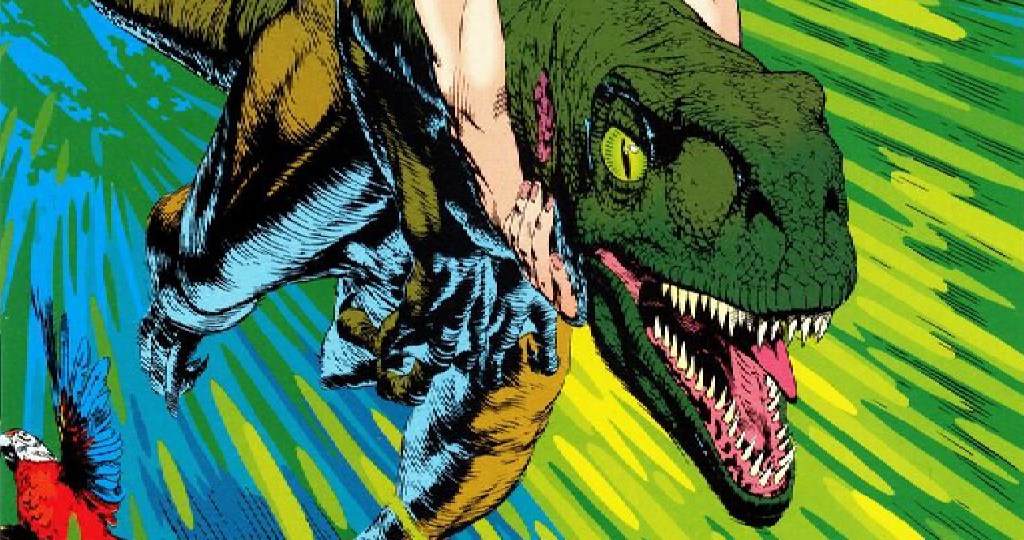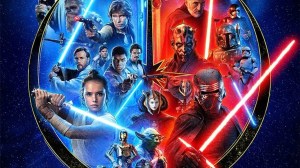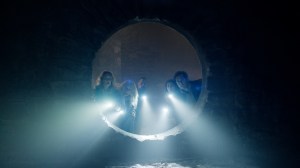Long before Chris Pratt was training raptors for military applications in Jurassic World, a fascinating but largely forgotten comic book series dared to imagine what would happen if velociraptors fell into the wrong hands. Released by Topps Comics in 1994, Jurassic Park: Raptors Attack and its sequel Raptors Hijack took the franchise in a bold direction that modern fans might find surprisingly dark and ambitious. These four-issue miniseries followed Dr. Alan Grant and Dr. Ellie Sattler as they became entangled with a Colombian drug lord’s scheme to transform stolen velociraptors into trained attack animals, setting off a chain of events that would challenge everything they thought they knew about these prehistoric predators.
Videos by ComicBook.com
The comic series, penned by Steve Englehart, ventured far beyond the confines of Isla Nublar into uncharted territory that the films wouldn’t explore for decades.
“We began before there were any Jurassic Park movie sequels, so I just ran with what’s in the first movie,” Englehart explains on his website, noting that they had “free reign” to expand the story in new directions.

That creative freedom resulted in plot elements that would seem outlandish even by modern franchise standards – from sign language-using raptors to corporate warfare that escalated into helicopter battles. At its core, the series tackled themes that would later become central to the franchise: the militarization of dinosaurs, the complex relationship between humans and these genetically engineered creatures, and the hubris of trying to control nature. However, the comics distinguished themselves by showing events from the raptors’ perspective, providing insight into their thought processes and even their dreams – a storytelling approach that revealed them as more than just movie monsters.
The comics also featured the surprising return of Robert Muldoon, the park’s game warden presumed dead in the film and explored an intriguing love triangle between Malcolm, Grant, and Sattler that added human drama to the dinosaur action. But perhaps most notably, they portrayed the velociraptors with unprecedented depth, giving them names (Alf, Betty, and Celia) and distinct personalities while maintaining their lethal nature.
Artist Neil Vokes, among others, brought these stories to life with dynamic artwork that captured both the terror and majesty of the prehistoric creatures. The series was particularly enhanced by Michael Golden’s stunning covers, which became collector’s items in their own right. These visual elements helped sell even the most outlandish plot developments, from raptors being worshipped as gods by indigenous tribes to their eventual mastery of basic communication with humans.
[RELATED – 10 Best Dinosaurs From the Jurassic World Movies (And How Realistic They Are)]
The series culminated in a storyline involving InGen’s rival company, Biosyn, attempting to establish its own dinosaur park, a plot point that would resurface years later in the modern film trilogy. However, the comics took a notably darker approach, with corporate warfare resulting in explicit violence that would never make it to the screen.
Three decades later, these comics stand as a fascinating experiment in expanding the Jurassic Park universe. While their more fantastical elements might seem at odds with the pseudo-scientific approach of the films, many of their core ideas – from trained raptors to corporate exploitation of dinosaur genetics – would eventually find their way into the mainstream franchise. In many ways, these comics were ahead of their time, daring to imagine a world where dinosaurs existed beyond theme park attractions and could become integrated (for better or worse) into modern society.
The series serves as a reminder that sometimes the most interesting franchise expansions happen in unexpected places when creators are given the freedom to explore new territory. Following Topps’ successful 1993 adaptation of the original film, these sequel comics took bold risks that continue to capture fans’ imaginations. On social media platforms like Reddit, enthusiasts frequently discuss how Raptors Attack could have made for a compelling film adaptation, particularly praising its unique blend of character drama and dinosaur action.
The influence of these comics on the franchise’s DNA remains evident, even if their wilder elements never made it to the big screen. While the modern Jurassic World films may have higher budgets and better special effects, they’ve yet to match the raw creative ambition of these 1994 comics. Perhaps most importantly, they proved that with the right balance of respect for the source material and creative freedom, the Jurassic Park universe could expand far beyond the confines of Isla Nublar’s electric fences.
Jurassic World Rebirth opens in theaters July 25th.








